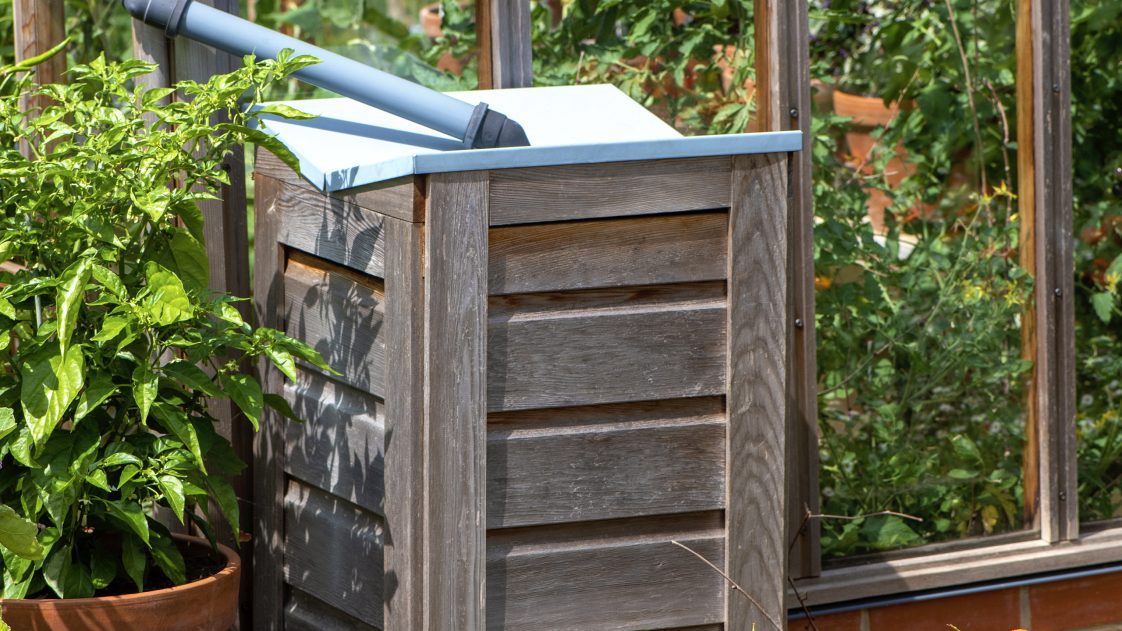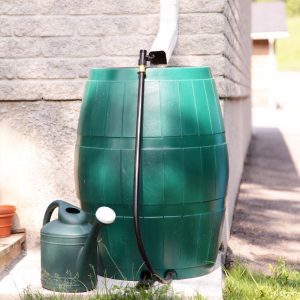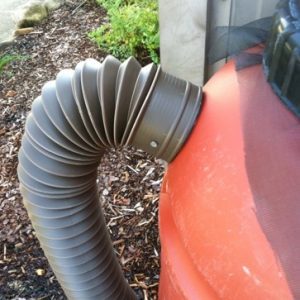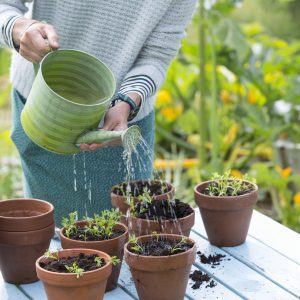Fish & Water

Moving Water From Rooftop To Rain Barrel
Gutter or no gutter, you can still harvest rainwater from your rooftop. Gutters are an easy transport mechanism that can be modified to direct rainwater directly into your barrel (figure 18).
Rooftop runoff can be directed to either vegetated areas (like a rain garden) or to a rain barrel or cistern by redirecting gutter downspouts. A good plan is needed for your entire project prior to disconnecting and redirecting the downspout.
Without a gutter, you can collect rainwater in the corners of your eaves where rain concentrates or utilize a rain chain to direct water into your rain barrel. Observe the path that water travels on your rooftop during a rain event.
Rain chains can be both useful and artistic elements in the home landscape. Designs vary from simple to complex (figure 19). Manufactured rain chains
are attractive ways to direct rainwater but can be expensive. Chains available at the local hardware store can be as effective and less costly, but they have a different aesthetic. We suggest finding alternatives to copper as a means to transport rainwater since some research suggests that trace copper in water can have a negative impact on fish.11
- Figure 18. Gutter and downspout directing water to ground. This would be a potential area to intercept water from a downspout and transfer it to a rain barrel or cistern.
- Figure 19. A rain chain is used to direct rain to a rain barrel. (Photo credit: Ken Mayer)
- Figure 20. Consider installing your rain barrel near plants where it can be used.
Identifying Where To Install
Once you have identified how water is collected from your roof, you can identify where your rain barrel will be placed and how you will use your captured rainwater.
1. Select downspouts or corners/eaves where water will be captured. Make sure you install an appropriately sized container and have space to direct overflow.
2. Determine a plan for water use based on landscape needs. Ideally a rainwater harvesting system does not sit full and is emptied in between rain events. A rain barrel should be located in close proximity to where the water will be used for irrigation. Water needs vary with weather, plant requirements, soil type, and sun or shade conditions. In drought conditions, categorize your plants based on water requirements. Harvested rainwater may be used first on priority plants that define the landscape. These may include heirloom, fruit, and vegetable gardens.
3. Map it out. It may help to print out an aerial view of the building where rooftop square footage can be estimated, downspouts can be located, and the catchment area and surrounding landscape are easily viewed. Alternatively, you can walk the property to identify downspouts and estimate catchment areas with a tape measure.
4. Consider using first flush diverters. If installing a cistern or larger-scale rainwater harvesting system, a first flush diverter should be considered. Dust, bird droppings, and tree debris can accumulate on the roof and other catchment surfaces between rain events.
A first flush diverter is a pipe that catches the first flush of water and has a plug or trickle drain on the bottom. Once this pipe fills up with the initial water, the remaining water bypasses the pipe and runs directly to the storage container. The plug at the end of the first flush diverter should be removed and the pipe drained after each rainfall event; if there is a trickle tube, the water will slowly clear from the tube.
Rain barrels typically do not require a first flush diverter since the inside of a rain barrel can be cleaned. If you are interested in these, however, you can find
more information on how to size and install first flush diverters in Rainwater Harvesting for Irrigation Water.12
- Figure 21. This yard with vegetation could benefit from a nearby rain barrel for watering plants.
- Figure 22. Olive barrel with overflow pipe to divert excess overflow away from foundation
- Figure 23. Hand-watering seedlings
Preparing Your Site
Once you have selected a location and identified a rainwater harvesting purpose, you will need to prepare your site.
Before disconnecting your downspout, you must estimate the height of your rain barrel. Clear the area of debris and create a stable surface. The ground should be level; if a platform is being built, that also should be a stable surface that can support a significant weight. A full 55-gallon rain barrel will weigh over 450 pounds! This is not something to be taken lightly. You want to ensure that the full rain barrel will not tip over and cause damage or injury.
Platform examples include stacked cinder blocks, stacked square paving stones, or a wooden platform. Here are some tips:
- A stable arrangement of cinder blocks makes a great platform for 60-gallon tanks but is not ideal for larger tanks as the blocks can easily shift.
- Pressure-treated 4 × 4–foot lumber laid out in alternating rows is a great option for a platform.
- Be sure that your platform is strong enough to withstand the weight of a full tank. Tanks are light when empty, but a full tank can weigh thousands of pounds. It is better to overbuild a strong platform than to underbuild a platform that will fail.
Raising your rain barrel will provide pressure coming out of the spigot. Just like water towers, rain barrels gain pressure by gaining height. A water level of 2.31 feet above its exit point will produce 1 psi (pounds per square inch). A rain barrel should be raised at least high enough to place a watering can or bucket under the spigot.
Most likely you will use your rain barrel to water by hand with a watering can or garden hose. The pressure generated from a small rain barrel will not be adequate to operate an in-ground sprinkler system or low-volume device such as a mist sprayer.
A soaker hose or drip irrigation system is an option if the water is applied in close proximity to the rain barrel and the rain barrel is elevated. For the soaker hose, water will leach out very slowly unless you remove the pressure-reducing washer to allow more water to flow through (this is the round insert at the beginning of the hose). Drip irrigation systems should have adjustable nozzles to regulate the rate of flow.
Due to the low volume of water stored in a rain barrel, a pump is not typically used. If considering a pump for a cistern, review Rainwater Harvesting for Irrigation Water.13
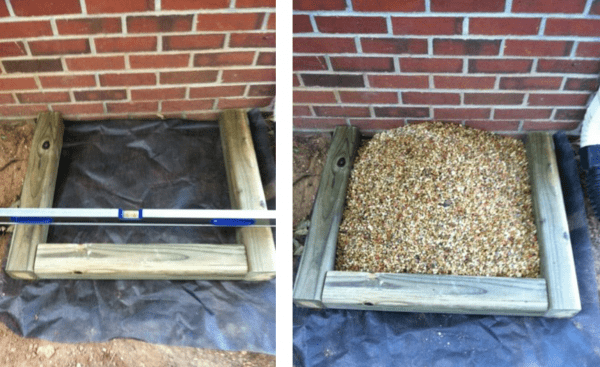
Figure 24. Make sure your platform is level before installing the rain barrel. Pea gravel can be used to create a supportive and easily leveled platform.
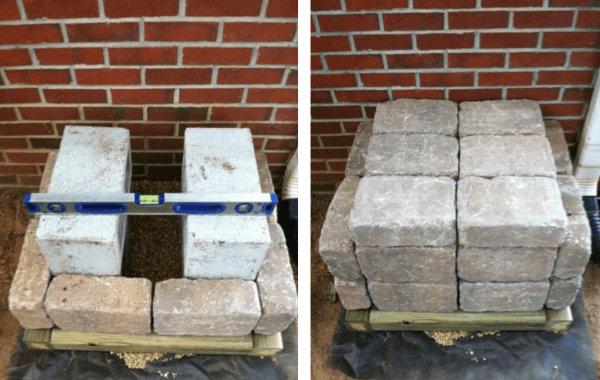
Figure 25. Make sure your rain barrel base is both level and secure. Elevating your barrel will increase your water pressure.
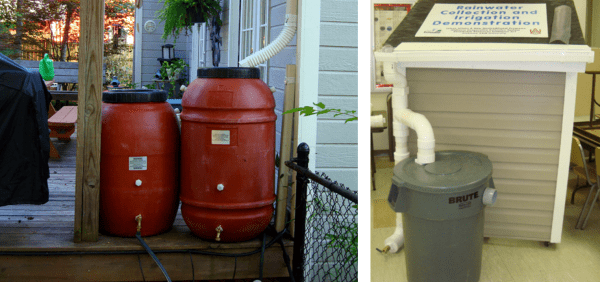
Figure 26. Rain barrel examples
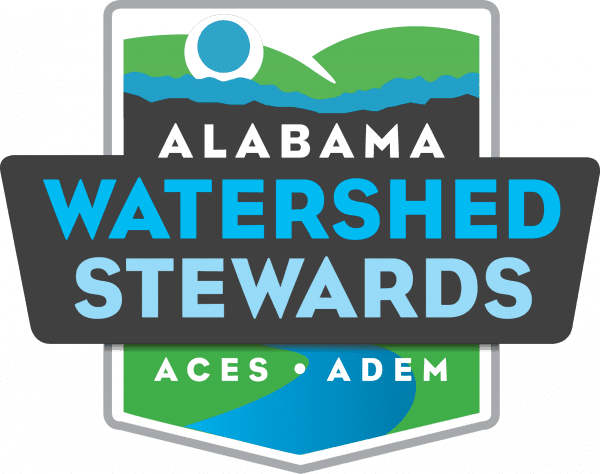
 Laura Bell, Project Coordinator; Eve Brantley, Extension Resources Specialist and Professor; Naomi Pitts, Watershed Program Assistant; and Caitlin Sweeney, Watershed Program Assistant, all with Alabama Extension Water Program, Auburn University
Laura Bell, Project Coordinator; Eve Brantley, Extension Resources Specialist and Professor; Naomi Pitts, Watershed Program Assistant; and Caitlin Sweeney, Watershed Program Assistant, all with Alabama Extension Water Program, Auburn University
Special thanks to Rhonda Britton, Regional Extension Agent, for her contributions to this handbook.
New August 2021, A Homeowner’s Guide to Rainwater Harvesting in Alabama, ANR-2794

